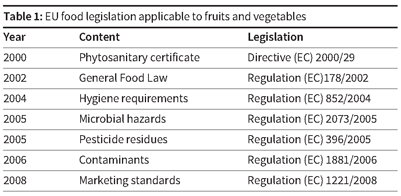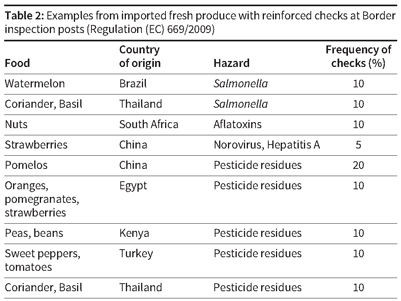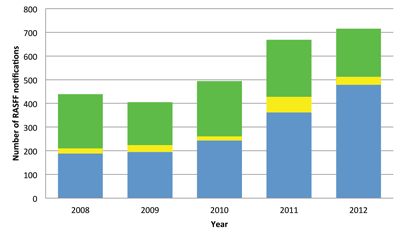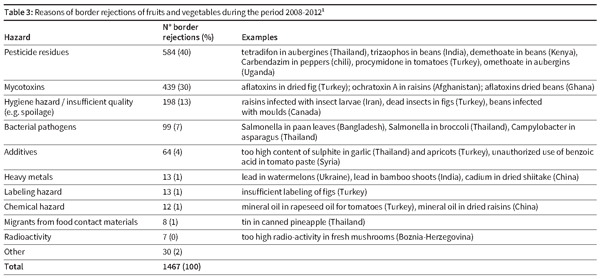Fresh produce rejections at EU border inspection posts
- Like
- Digg
- Del
- Tumblr
- VKontakte
- Buffer
- Love This
- Odnoklassniki
- Meneame
- Blogger
- Amazon
- Yahoo Mail
- Gmail
- AOL
- Newsvine
- HackerNews
- Evernote
- MySpace
- Mail.ru
- Viadeo
- Line
- Comments
- Yummly
- SMS
- Viber
- Telegram
- Subscribe
- Skype
- Facebook Messenger
- Kakao
- LiveJournal
- Yammer
- Edgar
- Fintel
- Mix
- Instapaper
- Copy Link
Posted: 4 November 2013 | Sigrid Van Boxstael, Liesbeth Jacxsens & Mieke Uyttendaele, Department of Food Safety and Quality, Ghent University | 1 comment
The consumption and coincident international trade of fresh produce has strongly increased during the last few decades. At present, the EU is one of the largest importers and exporters of fresh produce in the world. Despite the beneficial health effects of fresh produce, there is a growing awareness concerning its microbial and chemical food safety. In the EU, in 2009 and 2010 respectively, 4.4 per cent and 10 per cent of the foodborne verified outbreaks were linked to the consumption of vegetables, fruits and juices. Such outbreaks have not only very severe consequences for public health but also a significant economic impact.


Sigrid Van Boxstael
The consumption and coincident international trade of fresh produce has strongly increased during the last few decades. At present, the EU is one of the largest importers and exporters of fresh produce in the world. Despite the beneficial health effects of fresh produce, there is a growing awareness concerning its microbial and chemical food safety. In the EU, in 2009 and 2010 respectively, 4.4 per cent and 10 per cent of the foodborne verified outbreaks were linked to the consumption of vegetables, fruits and juices. Such outbreaks have not only very severe consequences for public health but also a significant economic impact.
The number of border rejections of fresh produce due to non-compliance with EU requirements also increased dramatically during the last few years. It is sometimes argued that due to these rejections, huge amounts of fruits and vegetables are discarded and represent high economic losses and food waste. The consequences of border rejections for importing to the EU such as restriction of access to the EU market and losses of trade value are discussed.
Food safety requirements on fresh produce entering the EU borders
Fruits and vegetables exported to EU are produced in countries from all over the world. Countries exporting to EU face stringent European legislative requirements. The basis for EU food safety public standards is laid down in the General Food Law or Regulation (EC) 178/2002. The main objective of this regulation is to secure a high level of protection for public health and consumer interests with regard to food products. The requirement of traceability ensures that products can be withdrawn from the market in the event of a problem. This law also specifies that products entering / leaving the EU market must comply with the EU food safety requirements such as maximum residue limits on pesticide residues and absence of microbial pathogens. Besides this, compliance to hygiene requirements is also to be documented and certificates of phytosanitary health are required (Table 1).


Table 1
Border controls on imported products
Fruits and vegetables and many other products entering EU borders are checked and controlled by EU Member States in Border Inspection Posts. In practice, overall about two per cent of the imports of non-animal origin are controlled. However, some products of non-animal origin that are perceived to have a higher food safety risk are checked at increased frequencies. The European Commission updates a list containing these high risk targeted products every three to six months, their origin and the hazard to be analysed (Annex 1 of Regulation (EC) 669/2009). The list is based upon several sources of information, e.g. notifications from the EU RASFF alert system, reports from the European Commission’s inspection service Food and Veterinary Office (FVO), scientific assessments from the European Food Safety Authority (EFSA) and exchange of information between EU Member States. Several examples of these products with reinforced checks (Version 2, February 2013) are presented in Table 2, e.g. 10 per cent of the consignments with watermelons imported from Brazil needs to be analysed for Salmonella and 10 per cent of the tomato consignments imported from Turkey needs to be analysed for pesticides residues.


Table 2
The Rapid Alert System for Food and Feed
The European Commission has created the communication portal Rapid Alert System for Food and Feed (RASFF) by which EU food control bodies notify each other when unsafe products have been detected and for which measures have been taken to protect consumers. These alerts are often based on the outcome of risk based inspections and monitoring plans by control bodies. The RASFF system contains three major categories: alert notifications, information notifications and border notifications. Alert and information notifications are used when food products presenting a health risk have been detected on the EU market. An alert notification urges an immediate action by the Member States (for example, recall from the market) while for an information notification, no rapid action is required (for example, because the product is no longer available on the market).
The third category, border control notifications, contains products that are stopped at entry of the EU borders. Depending on the final outcome of the inspection (checking compliance with EU food safety legislation via visual inspection, microbial and chemical analyses), the products can be released or rejected. In the latter case, the products are sent back to the country of origin, destroyed or given another destination. During the period 2008 – 2012, for fruits and vegetables, 1087 alert and information notifications and 1467 border control notifications were notified. In total, 88.5 per cent of the 1467 border control notifications resulted in a rejection of the fruits and vegetables.
Type of food safety problems on rejected fresh produce
Analysis of RASFF notifications shows an increasing number of notifications on fruits and vegetables from 439 in 2008 to 716 in 2012. This trend is mainly due to an increase in border rejections which increased from 188 in 2008 to 479 in 2012 (Figure 1).


Figure 1. Evolution of original RASFF notifications related to fruits and vegetables (period 2008-2012)1. Green: alert and information notifications (EU market notifications) Blue: border control notifications resulting in rejection of fruits and vegetable (border rejection); Yellow: border control notifications resulting in positive release of fruits and vegetables
In the frame of Veg-i-Trade, a European FP7 project studying the impact of globalisation and climate change on food safety (www.veg-i-trade.org), a discussion forum with experts from the whole fresh produce supply chain was organised to capture opinions on the safety of fresh produce. The outcome of this forum revealed that globalisation and increasing international trade was indicated as the major contextual factor increasing the food safety risk of fresh produce in EU. This finding seems to be in agreement with the increasing number of rejections but one should take also into account that both the trade volumes increased and controls became more intense on products from outside the EU.
Border rejections of fruits and vegetables are a result of the presence of hazards from both chemical and microbial origin (Table 3). Exceeding the maximum residue level (MRL) of pesticides and/or use of unauthorised pesticides represents 40 per cent of the rejections of fruits and vegetables. For example, aubergines (Thailand) and beans (India) have been rejected because of too high levels of tetradifon and triazophos, respectively. The second important cause is presence of mycotoxins, in particular on dried fruits such as figs or raisins. Adulteration of the fruits and vegetables due to insufficient hygiene is also an important reason for rejections, for example beans infected with moulds. The number of rejections due to Salmonella and other bacterial pathogens are on the rise and receive increasing international attention.


Table 3
Costs linked to EU rejections of fresh produce
Food losses and waste are an important socio-economic problem. A report by Gustavsson et al. (2011) estimated that globally about 50 per cent of fruits and vegetables are lost or wasted. The challenges to reduce these losses in developing countries and developed countries are different. In developed countries, a lot seems to be wasted by consumers while in developing countries, the losses are due to problems such as inadequate storage facilities, pests and managerial and technical limitations in harvesting techniques.
It is sometimes argued that the economic and food losses due to withdrawal of unsafe food at EU borders can be significant for exporting countries. Although the economic damage for individual exporters / farmers can be high, a report by the United Nations Industrial Development Organisation (UNIDO) concludes that within a broad trade context this seems to be the case less often. UNIDO, who were handed the public EU RASFF data, calculated the value lost via rejections for fruits and vegetables between 2004 and 2008 : the value was in total nine million US dollars and represented only 0.01 per cent of the traded value of fresh fruits and vegetables exported to the EU. Hence, the major cost of rejections does not concern the lost value but relates to the difficulties that countries face to comply with food safety and quality standards, a prerequisite for exporting to the EU. Furthermore, after occurrence of RASFF border notifications, products originating from developing countries risk joining the list of reinforced checks of Regulation (EC) 669/2009 as mentioned above and having an impact on trade relationships. Besides the difficulties countries face in complying with EU legislation, private standards (e.g. BRC, GlobalGAP) require an increasingly important adaptation to food safety management systems.
Strategies to better comply with food safety and quality standards
In several countries, the compelling need to tackle food safety issues remains among the critical constraints in international trade of fresh produce with the EU. The European Commission has set up the ‘Better Training for Safer Food’ programme, covering food and feed law, animal health and welfare and plant health rules. Via this programme, EU Member States and candidate countries involved in official controls are trained, but this training is also organised specifically for developing countries (particularly emerging economies and trade partners). The aim is to keep participants up-to-date with EU law and also to ensure more harmonised and efficient controls. Efficient controls are an essential factor in maintaining high levels of consumer protection, animal health and plant health. Additionally, in training participants from developing countries, the aim is to ease access for their products into the EU market and subsequently to keep the border rejections as low as possible. The United Nations Economic Commission for Europe (UNECE) also organises training courses on a regular basis to increase trade capacity of countries but also helps to develop standards for fruits and vegetables. On an international level, the Aid for Trade program by the WTO initiated in 2005 focuses on identifying the needs within recipient countries, responding to donors and acting as a bridge between donors and developing countries. Aid for Trade supports countries overcoming supply side constraints such as lack of knowledge, excessive red tape, inadequate financing and poor infrastructure.
On a national level, several organisations also enrol initiatives to increase the trade capacity and awareness of food safety. An example of such an initiative is an international training program (ITP) in Belgium on food safety, quality assurance and risk analysis by Ghent University (Department of food Safety and Quality) and funded by the government department VLIR-UOS. During three months participants from countries from south of Europe (e.g. Tanzania, Vietnam, Kenya, Bolivia etc) are trained. Trainees are selected on a yearly basis after an open call for participants.
Governments can also develop strategies to deal with the consequences of rejections of their products and maintain or even increase their access to the EU export market. An example is India who struggled with several rejections of grape consignments during 2003 due to illegal use of pesticides such as methomyl. APEDA, the Agricultural and Processed Food Products Export Development Authority from India, has subsequently taken several steps. First they changed their regulation to control pesticide residues in grapes exported to the European Union. They also upgraded laboratories, set up an international reference laboratory and trained farmers, exporters and analysts and gave farmers the opportunity of additional testing of their consignments. APEDA also initiated GrapeNet, an internet based platform for facilitating testing and certification of grapes for export from India to the EU. GrapeNet collects, stores and reports data entered by the stakeholders, i.e., exporters, laboratories and authorities within the grapes supply chain in India. Although there were still some problems with pesticides on imported grapes in 2010, the GrapeNet system generated trust. These efforts were fruitful to reduce the food safety risks as in 2011 – 2012, no consignments with Indian grapes were rejected by the EU. Furthermore, the exported volume of fresh grapes to EU-27 increased from 11,000 tons in 2002 to 37,000 tons in 2012.
Another case study in tackling food safety concerns expressed by EU consumers relates to the import of hot peppers from Uganda to the EU. In 2012, Uganda exported 1,640 tonnes of hot peppers to EU-27 and is among the largest exporters of hot peppers for consumption to EU-27. It faces international competition from Morocco (10,700 tonnes), Turkey (12,200 tonnes) and Ghana (2,060 tonnes). Complying with the EU food safety regulations, in particular the MRLs on pesticides, remains a huge challenge. Farmers and traders from Uganda were supported by the EU Pesticide Initiative Program (PIP) to ensure compliance of the Uganda fresh produce to EU requirements. The export volumes of hot peppers increased from 260 tonnes in 2002 to 1640 tonnes in 2012 but remained stable during the last few years. In order to further increase the market share, it is necessary to build the trust and confidence of importers and retailers in the EU as to the safety and quality of the produce delivered by Uganda. The Uganda hot pepper supply chain has exploited the food safety concerns of EU consumers and reacted to it by setting up a now successful self-regulated and well-organised certified organic agricultural subsector which enabled several Uganda hot peppers farmers to obtain access to the premium EU market.
Conclusions
The EU is one of the largest importers of fresh produce originating from countries from the south of Europe. An increasing number of EU border rejections by the RASFF system has been observed during the last few years. Although each individual case may represent a high economic loss and food waste for the involved exporters or individual farmers in developing countries, the main problem still associated with border rejections is the overall loss of trust and confidence by buyers in EU in the safety and quality of the produce delivered by the country of origin. Stringent food safety requirements, both from a legislative and private nature, are identified as important bottlenecks to gain access to the high value EU market. Capacity building programs by various international and regional organisations is one strategy to increase access to global fresh produce trade markets. Besides this, local governments and private organisations in third countries also take up this stringent EU requirements and border rejections as incentives to develop appropriate strategies for better compliance with set standards and thus provide safe and high quality fresh produce to EU consumers. These combined approaches of setting standards, checking, training and well elaborated strategies to accomplish compliance to set requirements will help countries to integrate in the global trading system which is crucial for securing growth and prosperity.
References
- APEDA (2013). GrapeNet software system of APEDA. http://www.apeda.gov.in/apedawebsite/Archive/GrapeNet/
- European Commission (2013). Better Training for Safer Food. http://ec.europa.eu/food/training_strategy/
- EFSA/ECDC (European food safety authority/european centre for disease control). (2012). The European union summary report on trends and sources of zoonoses, zoonotic agents and food-borne outbreaks in 2010. EFSA Journal, 10, 2597-3039.
- FAO (2013). FAO training on GAP. http://www.fao.org/prods/gap/resources/training_en.htm
- Ghent University Food Safety and Quality Department (2013). International Training Program for Foods. http://www.itpfoodsafety.ugent.be/index.asp
- Gustavsson, J., Cederberg, J., Sonesson, J., van Otterdijk, J. & Meybeck, A. (2011). Food and Agricultural Organization/World Health Organization. Global food losses and food waste. 1-29. www.fao.org/docrep/014/mb060e/mb060e00.pdf
- Maudoux, J.P., Saegerman, C., Rettigner, C., Houins, G., Van Huffel, X. & Berkvens, D. (2012). Food safety surveillance through a risk based control programme: Approach employed by the Belgian Federal Agency for the safety of the food chain. Veterinary Quarterly, 28, 140-154.
- Preißel, S., Reckling, M. (2010). Smallholder group certification in Uganda – Analysis of internal control systems in two organic export companies. Journal of Agriculture and Rural Development in the Tropics and Subtropics, 111, 13-22.
- RASFF. (2012). Rapid Alert System for Food and Feed. 2011 Annual report. 52 p.
- RASFF (2013). On-line database Rapid Alert System for Food and Feed. http://ec.europa.eu/food/food/rapidalert/index_en.htm
- UNIDO (2011). United Nations Industrial Development Organization. Meeting standards, Winning Markets. Trade Standards compliance 2010.
- Uyttendaele, M., Jacxsens, L., & Van Boxstael, S. (2013). Issues surrounding the European fresh produce trade : a global perspective. Edited by M. Hoofer.
- Van Boxstael, S., Habib, I., Jacxsens, L., De Vocht, M., Baert, L., Van de Perre, E., Rajkovic, A., Lopez-Galvez, F., Sampers, I., Spanoghe, P., De Meulenaer, B. & Uyttendaele, M. (2013). Food safety issues in fresh produce: Bacterial pathogens, viruses and pesticide residues indicated as major concerns by stakeholders in the fresh produce chain. Food Control 32, 190-197.
- UNECE (2013). Capacity building for trade of fruits and vegetables. http://www.unece.org/trade/agr/promotion/promotioncapacitybuilding.html
- WTO (2013). Aid For Trade program. http://www.wto.org/english/tratop_e/devel_e/a4t_e/aid4trade_e.htm
Biographies


Sigrid Van Boxstael
Sigrid Van Boxstael has a diploma of Bio-Science Engineering (1998) at the Faculty of Bio-Engineer Sciences of Ghent University where she gained her Master’s thesis at the Department of Food Safety and Quality on the PCR detection of Escherichia coli in ground beef (1998). She obtained her PhD at the Free University of Brussels with her study on structure and kinetics of the enzyme asparate transcarbamylase of the hyperthermophilic Archaeon Pyrococcus abyssi (2004). After her PhD, she worked for eight years at the risk assessment department of the Belgian Food Safety Agency (2010). She is currently working at the Department of Food Safety and Quality of Ghent University on the FP7 project ‘Impact of globalisation and climate change on the food safety of fresh produce’ where she focuses on the impact of standards in the fresh produce supply chain.


Liesbeth Jacxsens
Liesbeth Jacxsens has a diploma of Bio-Science Engineering (1997) and PhD in Applied Biological Sciences from Ghent University, Belgium. She is involved in the research of the EU 7th FP project Veg-i-Trade (www.vegitrade.org) where she is investigating the performance of food safety management systems. She further has collaborated on many projects on microbiological and chemical risk assessment. In the Veg-i-Trade project, she is also training manager and responsible for training and capacity building in ICPC countries. She was involved in the ITP food safety, quality assurance and risk analysis which is organised by UGent-VLIR (www.itpfoodsafety.ugent.be). She is currently dr. assistant of quality assurance and risk analysis for the laboratory of food microbiology and food preservation (LFMFP) and NutriFoodChem of the Department of Food Safety and Food Quality of Ghent University.


Mieke Uyttendaele
Mieke Uyttendaele has a diploma of Bio-Science Engineering (1992) and PhD in Applied Biological Sciences (1996) from Ghent University, Belgium. She further pursued research as a postdoc of the Belgian National Fund of Scientific Research. Prof. Mieke Uyttendaele’s research area covers aspects of Microbial Analysis of Foods (classical culture methods and rapid methods) and Food Safety (including a wide variety of pathogens and including both animal and non-animal products). She has been/is an ad hoc member of several EFSA panels’ working groups and member of the Scientific Committee of the Belgian Food Safety Agency since 2009. She now holds an academic position as Research Professor at Ghent University since 2004 situated at the Department of Food Safety and Food Quality of the Faculty of Bio-Science Engineering of Ghent University in Belgium.









Interesting article and good bibliography.